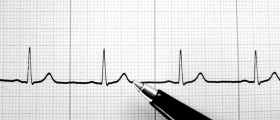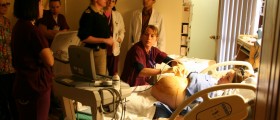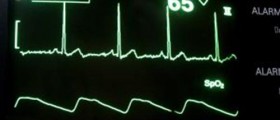
In fact, fetal heart beat monitoring, being one of the invaluable hospital methods of maintaining the health of babies during labor, is not available to be used at home. Many health practitioners do not approve of this form of home fetal monitoring, though. However, many others promote this method of monitoring.
Fetal Heart MonitoringFetal heart monitoring is a method which is advised to be used once pregnant women experience abnormalities in the heartbeats of their babies. Bearing in mind that most of the stillborn deaths take place during the time when the mother is asleep, fetal monitoring of the heartbeats is very important for preventing these sorts of occurrences.
Namely, while the mother is asleep, her blood pressure drops and this is not good for the child inside of her body. Moreover, being in horizontal position decreases the room inside of the pelvic area and this situation can possibly lead to health complications affecting the baby.The fetal heart monitors perceive abnormalities in the heart beats of the babies inside the wombs, notifying the mothers on time, before any permanent damage is done.
Surely, the mother can be aware of the activity of the child in her womb during the day. Yet, when she is asleep, this might not be that easy. This is where the fetal heartbeat monitoring can be incredibly helpful, helping you keep track of your pregnancy and react timely in case any abnormalities appear.
Two main types of fetal heartbeat monitoring exist. The first one is external and involves the procedure described above. Basically, a special type of stethoscope picks up information on the heartbeats and the sensors located on the belts which are placed on the abdomen recording the child's activity too. This is a non-invasive form of fetal heartbeat monitoring, allowing you to either hear the information through beeps or see it through printed charts.On the other hand, the monitoring may be internal. Here, the heart activity of your baby is monitored through electrodes being placed on the scalp of the child, collecting information on the heartbeats. Naturally, this form of monitoring is not possible unless the water has broken. As for collecting the information on the contractions of the uterus, a small tube is inserted inside the vagina, delivering information on the activity of the uterus, which is later being printed onto a chart.
Internal fetal heartbeat monitoring is considered to be much more effective than the external one. Nevertheless, due to the fact that the former is invasive, the latter is the only method which can be applied and used at home.Regardless, external fetal heart rate monitoring can provide you with crucial information on your baby's health, monitoring your placenta, your uterus and your baby.
How To Use Fetal Heart MonitorFirst of all, it is good to have a small meal before this form of fetal monitoring, since the digesting of the food makes the baby move more. However, if you are having a contraction stress test, you will be asked not to consume any food or drinks for up to 8 hours before the procedure. Keep in mind that smoking decreases the activity of your baby and may interfere with the results of the fetal heart rate monitoring.
If you are bearing all these factors in mind, you can undergo fetal heart rate monitoring anytime after your 20th week of pregnancy. Due to the factors mentioned above, internal monitoring of this type is possible only during the final stages of pregnancy, during labor, when it can be used alone or in combination with the external method.All in all, electronic fetal monitoring is an excellent method for keeping track of your baby's health and your own health at the same time. Having your baby's heart rate monitored at home can prevent many problems related to the health of your baby, especially during bedtime, where the mother's blood pressure drops and chances of decreasing the baby's blood supply increase.
















Your thoughts on this
Loading...